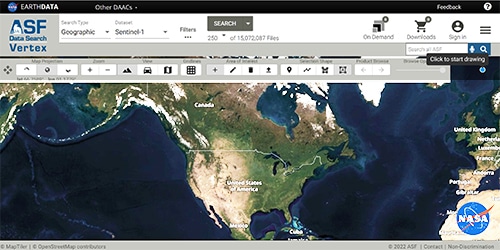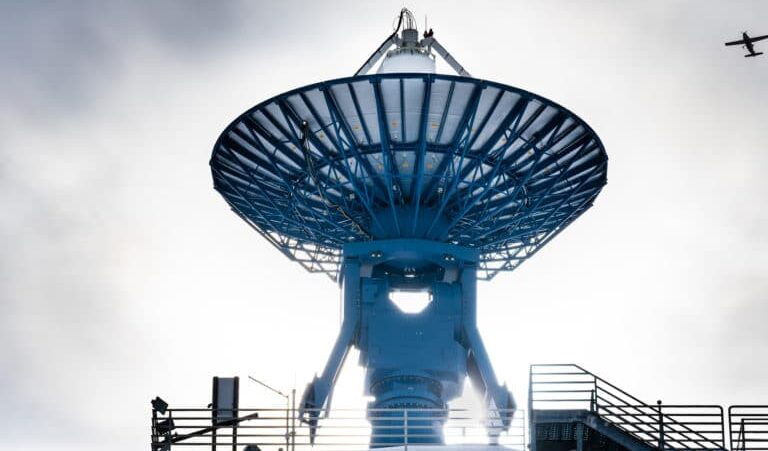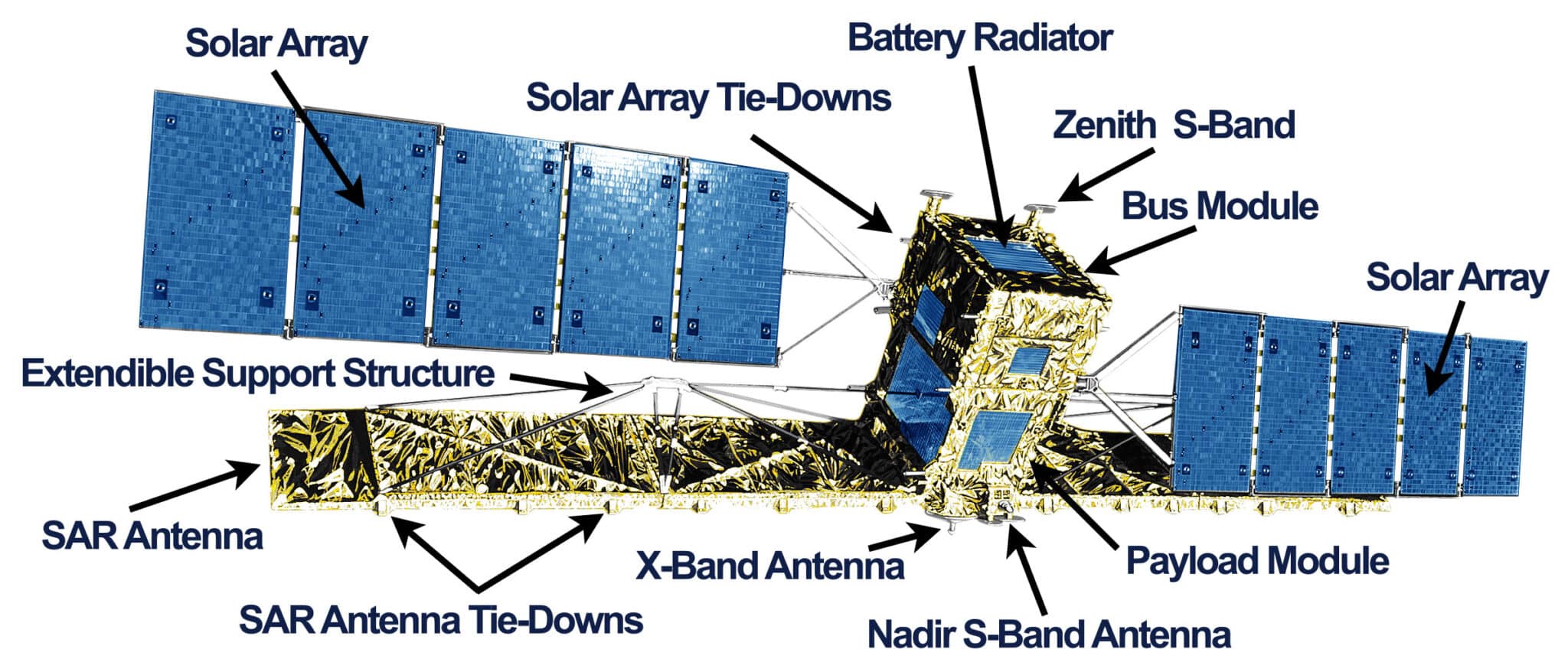RADARSAT-1

The Canadian Space Agency’s (CSA) Remote Sensing satellite (RADARSAT-1) was launched in November 1995, and stopped transmitting because of a technical anomaly in March 2013. It was equipped with synthetic aperture radar (SAR), a powerful microwave instrument. It transmitted and received signals to capture high-quality images of the Earth night and day and in all weather conditions. RADARSAT-1 transmitted a microwave energy pulse (C-band at 5.3 GHz frequency) to Earth, and the SAR measured the amount of energy reflected back to the satellite from the Earth’s surface.
The RADARSAT-1 data archive via the ASF DAAC is now free and open. This is an unrestricted dataset, and users are free to copy, modify, publish, translate, adapt, distribute or otherwise use the RADARSAT-1 information in any medium, mode or format for any lawful purpose. Learn more about the Canada’s Open Government License.


Overview
RADARSAT-1 collected Synthetic Aperture Radar (SAR) data from 1995-2008. The instrument had worldwide coverage, with extensive coverage of Arctic Ocean sea ice. The datapool contains ASF standard beam odd frames, as well as the first and last frame of each imaged swath. The datapool also contains all Fine Beam 1 frames in a CEOS — Level 0 and Level 1 framed format.
| Dataset Property | Fine Beam Mode | Standard Beam Mode | ScanSAR Beam Mode |
|---|---|---|---|
| Temporal Coverage | 1995-2008 | 1995-2008 | 1995-2008 |
| Repeat Cycle | 24 days | 24 days | 24 days |
| Spatial Coverage | Worldwide coverage, with extensive coverage of Arctic Ocean sea ice | Worldwide coverage, with extensive coverage of Arctic Ocean sea ice | Worldwide coverage, with extensive coverage of Arctic Ocean sea ice |
| Center Frequency | 5.3 GHz/C-band 5.6 cm | 5.3 GHz/C-band 5.6 cm | 5.3 GHz/C-band 5.6 cm |
| Polarization | HH | HH | HH |
| Spatial Resolution | 8 m | 30 m | 50-100 m |
| Swath Width | 50 km | 100 km | 300-500 km |
| Off-Nadir Angle | 37-47° | 20-49° | 20-49° |
| File Format | CEOS — Level 0 and Level 1 framed | CEOS — Level 0 and Level 1 framed | CEOS — Level 0 and Level 1 framed |
| Download Information | Data Discovery | Data Discovery | Data Discovery |
| Date Published | 1995 | 1995 | 1995 |
Expand the sections below to view content. Access the full content on a single page by clicking the button.
User Guides/Technical Information
RADARSAT-1 Level 1 Standard Beam Data Coverage
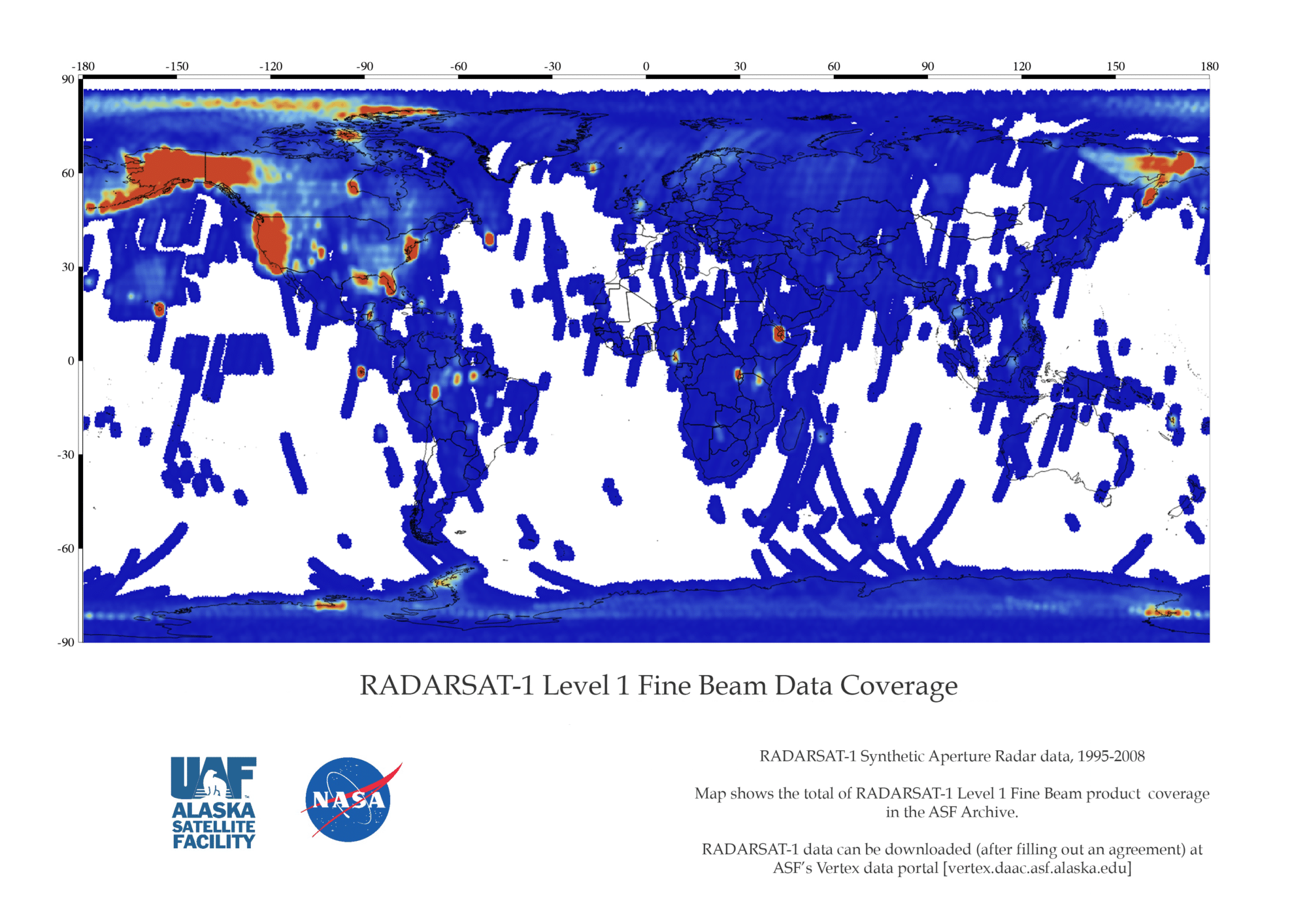
RADARSAT-1 Level 1 Fine Beam Data Coverage

RADARSAT-1 Level 1 ScanSAR Wide Beam Data Coverage
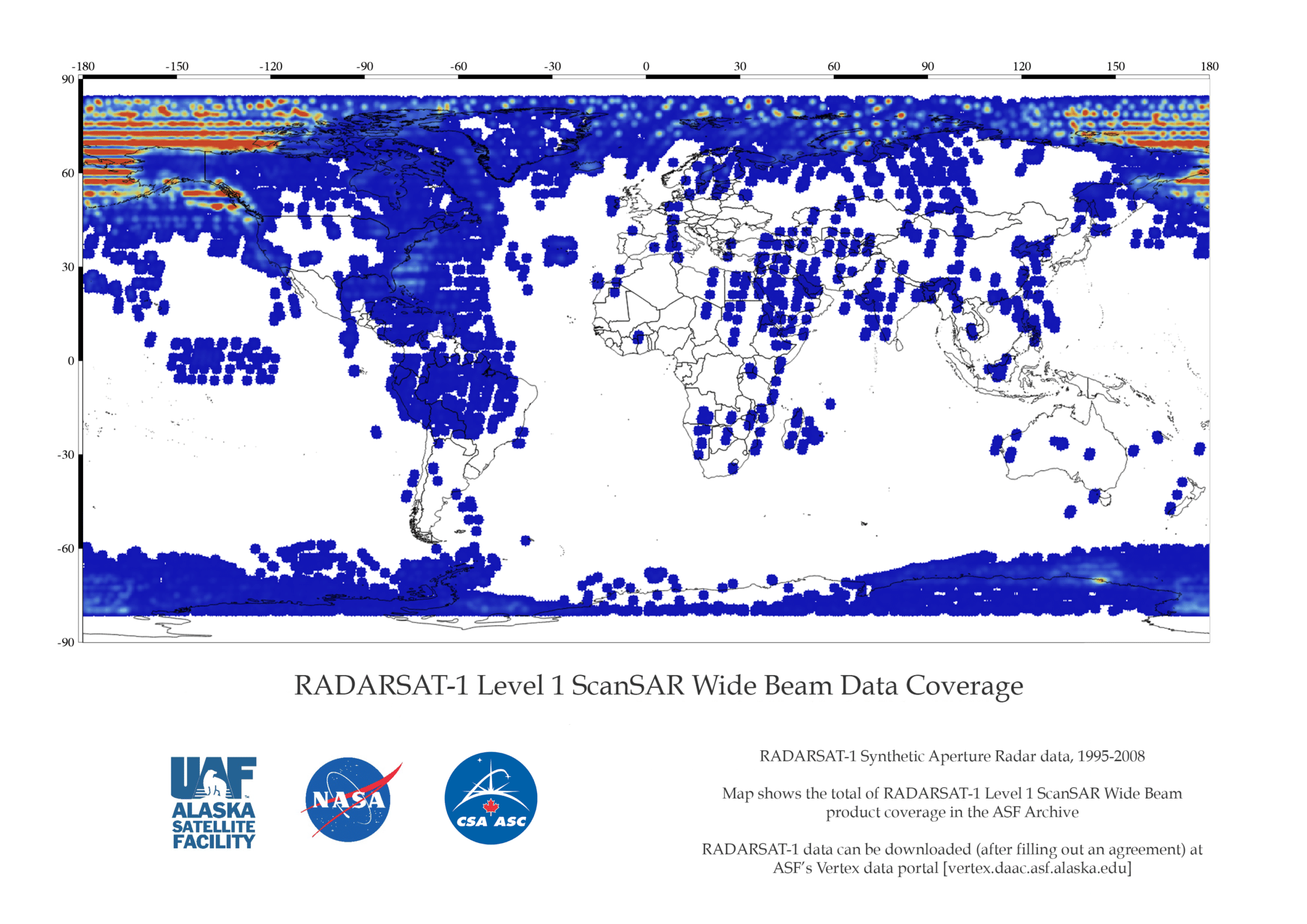
Instrument
RADARSAT-1 was equipped with a powerful SAR sensor. It transmitted and received signals to capture high-quality images of the Earth night and day and in all weather conditions. RADARSAT-1 transmitted a microwave energy pulse (C-band at 5.3 GHz frequency) to Earth, and the SAR measured the amount of energy reflected back to the satellite from the Earth’s surface.
The RADARSAT-1 instrument was able to shape and steer its radar beam using C-band. A wide variety of beam widths were available to capture swaths of 45 to 500 kilometers, with a range of 8 to 100 meters in resolution and incidence angles of 10 to 60 degrees.
Radarsat-1 Beam Modes
| Parameter | Fine Beam Mode | Standard Beam Mode | ScanSAR Beam Mode |
|---|---|---|---|
| Center Frequency | 5.3 GHz/C-band 5.6 cm | 5.3 GHz/C-band 5.6 cm | 5.3 GHz/C-band 5.6 cm |
| Polarization | HH | HH | HH |
| Spatial Resolution | 8 m | 30 m | 50-100 m |
| Swath Width | 45 km | 100 km | 300-500 km |
| Off-Nadir Angle | 37-47° | 20-49° | 20-49° |
The RADARSAT Data Product Specifications Guide provides an overview of the endorsed products generated by the RADARSAT program. This document outlines the suite of available RADARSAT products, the product delivery options, and product attributes such as image quality, resolution and size. The CEOS format for RADARSAT data is also defined for each record in structure and contents.
RADARSAT-1 Products
Downloadable Products
Downloadable Products include Level 0 (raw data), Level 1 (amplitude image), Left-looking and Antarctica mosaics.
* NOTE: Exact swath varies with incidence angle and the latitude of the image footprint.
| Beam Mode | Beam Position | Incidence Angle (degrees) | Resolution Range x Azimuth (m) | Real Time swath* (km) |
|---|---|---|---|---|
| Standard | S1 | 24-31 | 24 x 27 | 100 |
| Standard | S2 | 30-37 | 20 x 27 | 100 |
| Standard | S3 | 34-40 | 25 x 27 | 100 |
| Standard | S4 | 36-42 | 23 x 27 | 100 |
| Standard | S5 | 41-46 | 22 x 27 | 100 |
| Standard | S6 | 45-49 | 20 x 27 | 100 |
| Standard | S7 | 39-42 | 19 x 27 | 100 |
| Beam Mode | Beam Position | Incidence Angle (degrees) | Resolution Range x Azimuth (m) | Real Time swath* (km) |
|---|---|---|---|---|
| Fine | F1 | 37-41 | 8.3 x 8.4 | 50 |
| Fine | F2 | 39-42 | 7.9 x 8.4 | 50 |
| Fine | F3 | 41-44 | 7.6 x 8.4 | 50 |
| Fine | F4 | 43-46 | 7.3 x 8.4 | 50 |
| Fine | F5 | 45-47 | 7.1 x 8.4 | 50 |
| Beam Mode | Beam Position | Incidence Angle (degrees) | Resolution Range x Azimuth (m) | Real Time swath* (km) |
|---|---|---|---|---|
| Wide | W1 | 20-31 | 33 x 27 | 150 |
| Wide | W2 | 31-39 | 35 x 27 | 150 |
| Wide | W3 | 39-45 | 21 x 27 | 150 |
| Beam Mode | Beam Position | Incidence Angle (degrees) | Resolution Range x Azimuth (m) | Real Time swath* (km) |
|---|---|---|---|---|
| Extended Low | EL-1 | 10-23 | 39 x 27 | 170 |
| Beam Mode | Beam Position | Incidence Angle (degrees) | Resolution Range x Azimuth (m) | Real Time swath* (km) |
|---|---|---|---|---|
| Extended High | EH1 | 49-52 | 18 x 27 | 75 |
| Extended High | EH2 | 50-53 | 18 x 27 | 75 |
| Extended High | EH3 | 52-55 | 17 x 27 | 75 |
| Extended High | EH4 | 54-57 | 17 x 27 | 75 |
| Extended High | EH5 | 56-58 | 16 x 27 | 75 |
| Extended High | EH6 | 57-60 | 16 x 27 | 75 |
| Beam Mode | Beam Position | Incidence Angle (degrees) | Resolution Range x Azimuth (m) | Real Time swath* (km) |
|---|---|---|---|---|
| Scan SAR Narrow | SNA | 20-39 | 50 x 50 | 300 |
| Scan SAR Narrow | SNB | 31-46 | 50 x 50 | 300 |
| Beam Mode | Beam Position | Incidence Angle (degrees) | Resolution Range x Azimuth (m) | Real Time swath* (km) |
|---|---|---|---|---|
| Scan SAR Wide | SWA | 20-49 | 100 x 100 | 500 |
| Scan SAR Wide | SWB | 20-46 | 100 x 100 | 450 |
* NOTE: Exact swath varies with incidence angle and the latitude of the image footprint.
Citation Information
How to Cite Data
Cite data in publications such as journal papers, articles, presentations, posters, and websites. Please send copies of, or links to, published works citing data, imagery, or tools accessed through ASF to [email protected]” with “New Publication” on the subject line.
| Format | Example |
|---|---|
| Dataset: RADARSAT-1, CSA [year of data acquisition]. Retrieved from ASF DAAC [day month year of data access]. | Dataset: RADARSAT-1, CSA 1999. Retrieved from ASF DAAC 7 December 2014. |
How to Cite Imagery
Include credit with each image shown in publications such as journal papers, articles, presentations, posters, and websites. (NASA does not copyright imagery.)
| Format | Example |
|---|---|
| © CSA [year of data acquisition] | © CSA 2002 |
RADARSAT-1 Datasets and DOIs
| L0_RADARSAT-1 | 10.5067/GXBUNGIGEOO3 |
| L1_RADARSAT-1 | 10.5067/KUIX1CRFDW44 |
Discover RADARSAT-1 data
Researchers can download RADARSAT-1 data from the NASA-sponsored ASF DAAC.
Data Discovery Tools
| Data Discovery Tool | Link |
|---|---|
| ASF Vertex Data Search | Vertex |
| Python Search Module | asf_search |
| ASF Search API | ASF Search API |
| NASA Earthdata Search | Earthdata Search |


